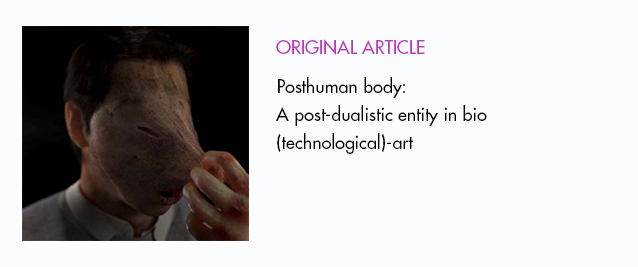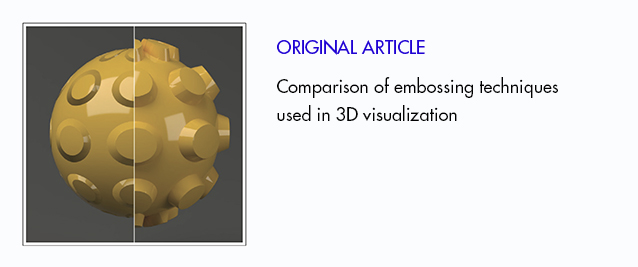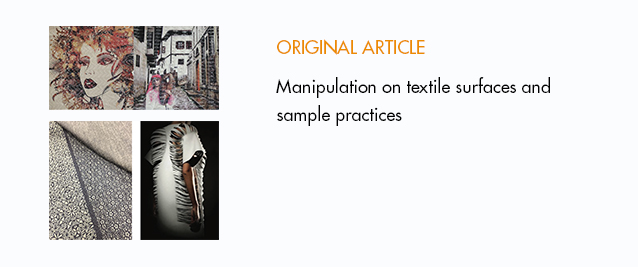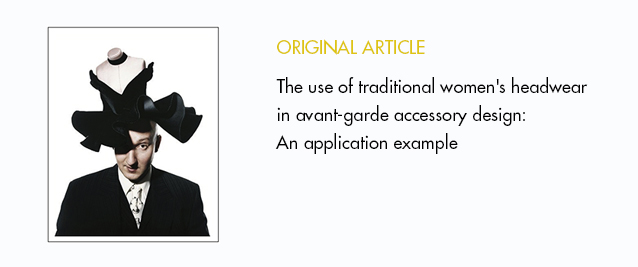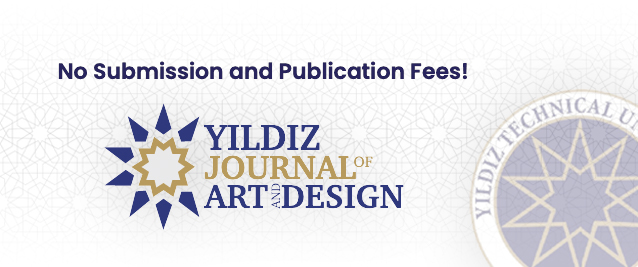AUTHOR GUIDELINES
- The submitted work cannot be a study published previously in another journal or one that has been submitted to another journal for consideration.
- The submission taken into consideration by the editors are sent to at least two referees for analyis of content and style. No identifying information is given to editors regarding the authors and vice versa. Reports from referee are confidential and submitted work for which approval of publication is not granted is not returned to the author and the submitted work is not published.
- Submissions must be done via DergiPark system and must not be sent through email. Authors need to sign up before being able to submit. Then, they can start the submission process by logging into the system.
-
The submission which are given revision by the referees are sent back to their authors for the reconsideration. It is the author's responsibility to resubmit their study via the same system. YJAD holds the copyright for the published studies. Legal, ethical and scientific responsibility belongs to the author.
- The main langugae of publication is Turkish; however, the studies written in English are also accepted after the approval of the editorial board.
- The published articles are listed according to the academic titles, which are also grouped alphanetical among themselves.
- No copyright fee is paid to the author after publication.
- Submissions must not include any identifying information like name, surname, affiliation or email, which will be requested from the author if the submitted work is accepted for publication.
- Authors can publish their studies published in YJAD before or after publication in their own personal web sites or institutional archieves by referring to YJAD in accordance with the international standards of library science.
-
Names and emails registered in the system of YJAD will only by used for the stated aims of the journal and will not be shared with any other parties for any purpose.
Types of article
Yıldız Journal of Art And Design, (YJAD) publishes material in the form of original articles, letters, reviews, case reports, technical notes and editorials.
Original articles. Full articles should generally be 4000-6000 words, excluding manuscript heading, abstract, acknowledgements, and funding. Tables and figures are not limited in number but no more than 6 in total is recommended; each (including their legends, captions and footnotes) will count as 150 words towards the total word count of 4500; tables with excessive word counts will have the total words included in the final manuscript word count, however, extended material may be published as Supplementary Materials. References are unrestricted in number, therefore not counted in the total word count.
In the case of Supplementary Material, please indicate if it can be published online only. Online-only Supplementary Material should be uploaded in separate file(s), and described in the manuscript, in order to allow proper linking.
Figures, tables and references must be prepared according to specific instructions (see below). There is no limit on the number of figures or tables, but please consider that the journal is limited for space and that it may be possible to present some figures and tables as online only Supplementary Data. For further information see Supplementary material section below. Supplementary tables or figures should be named and numbered accordingly (S1, S2 etc.) in the manuscript and in the file.
Similarly, it may be possible to present an extended bibliography for online-only presentation.
Page charges
This journal has no page charges.
Informed consent
Studies on volunteers require ethics committee approval and informed consent, which should be documented in the paper. Appropriate consents, permissions and releases must be obtained where an author wishes to include case details or other personal information or images of patients and any other individuals in an YTU publication. Written consents must be retained by the author but copies should not be provided to the journal. Only if specifically requested by the journal in exceptional circumstances (for example if a legal issue arises) the author must provide copies of the consents or evidence that such consents have been obtained.
Declaration of Potential Conflicts of Interest
Any financial interests or connections, direct or indirect, or other situations that might raise the question of bias in the work reported or the conclusions, implications or opinions stated - including pertinent commercial or other sources of funding for the individual author(s) or for the associated department(s) or organization(s), personal relationships, or direct academic competition - should be disclosed. Examples of potential conflicts of interest include employment, consultancies, stock ownership, honoraria, paid expert testimony, patent applications/registrations, and grants or other funding.
If there are none, the disclosure should say: 'The authors have declared no conflicts of interest.'
If one or a few authors have a conflict to disclose, further to that statement, there should be an additional statement for those remaining authors who do not have any, e.g. 'All remaining authors have declared no conflicts of interest.'
Submission declaration and verification
Submission of an article implies that the work described has not been published previously (except in the form of an abstract, a published lecture or academic thesis, see 'Multiple, redundant or concurrent publication' for more information), that it is not under consideration for publication elsewhere, that its publication is approved by all authors and tacitly or explicitly by the responsible authorities where the work was carried out, and that, if accepted, it will not be published elsewhere in the same form, in English or in any other language, including electronically without the written consent of the copyright-holder. To verify originality, your article may be checked by the originality detection service CrossRef Similarity Check.
Changes to authorship
Authors are expected to consider carefully the list and order of authors before submitting their manuscript and provide the definitive list of authors at the time of the original submission. Any addition, deletion or rearrangement of author names in the authorship list should be made only before the manuscript has been accepted and only if approved by the journal Editor. To request such a change, the Editor must receive the following from the corresponding author: (a) the reason for the change in author list and (b) written confirmation (e-mail, letter) from all authors that they agree with the addition, removal or rearrangement. In the case of addition or removal of authors, this includes confirmation from the author being added or removed.
Only in exceptional circumstances will the Editor consider the addition, deletion or rearrangement of authors after the manuscript has been accepted. While the Editor considers the request, publication of the manuscript will be suspended. If the manuscript has already been published in an online issue, any requests approved by the Editor will result in a corrigendum.
Copyright
Manuscripts should be sent with the Copyright-Authors’ Approval-Conflict of Interest Letter signed by the author(s). A copy of this letter can be found at https://yjad.yildiz.edu.tr. Manuscripts will not be accepted for evaluation until the receipt of this document by the Journal.
Role of the funding source
Details of all funding sources for the work in question are mandatory; please include a funding statement before the disclosure, or add 'none declared'.
Open access
YJAD is an open access journal, which means that all content is freely available without charge to the user or his/her institution. Users are allowed to read, download, copy, distribute, print, search, or link to the full text of the articles in YJAD without asking prior permission from the publisher or the author. This is in accordance with the Budapest Open Access Initiative (BOAI) definition of open access.
The BOAI arose from a meeting convened in Budapest by the Open Society Institute (OSI) on December 1-2, 2001. The purpose of the meeting was to accelerate progress in the international effort to make research articles in all academic fields freely available on the Internet. The participants represented many points of view, many academic disciplines, many nations, and had experience with many of the ongoing initiatives that make up the open access movement. In Budapest, they explored how the separate initiatives could work together to achieve broader, deeper, and faster success. They explored the most effective and affordable strategies for serving the interests of research, researchers, and the institutions and societies that support research. Finally, they explored how the OSI and other foundations could use their resources most productively to aid the transition to open access and to make open access publishing economically self-sustaining. The result was the BOAI. It is at once a statement of principle, a statement of strategy, and a statement of commitment.
When an author chooses to make their article open access, their article is made free to read and reuse immediately upon publication under a Creative Commons Attribution-NonCommercial 4.0 (CC BY NC) license. This allows users to copy and distribute the article, provided this is not done for commercial purposes. It further does not permit distribution of the article if it is changed or edited in any way, and provided the user gives appropriate credit (with a link to the formal publication through the relevant DOI), provides a link to the license, and that the licensor is not represented as endorsing the use made of the work.
Submit your article
Please submit your article via the online submission web site. DergiPark https://dergipark.org.tr/en/pub/yjad
PREPARATION
Article Structure
Each study must have an abstract of 250-300 words both in Turkish and English.
There must be at least 5 key words, written in both Turkish and English.
All written work must be between 4000-6000 words including references, appendices and endnotes. It must be written in one of up-to-date versions of MS Word.
Page loyout, font size, paragraph and line spacing must be as follows:
Page size: A4 portrait, Margins on the page 2.5 cm from all four sides.
Indentation: 1 cm, Long quotation: 10 pt, 1 cm from the left side, Font: Times New Roman, Style: Normal, Font size: 11 pt,j ustified
Endnotes: 9 pt, Paragraph Spacing: 8 nk, Body line spacing: 1,5, Abstract and Öz line spacing: 1
Format in the main body of the text must be arranged as follows:
NAME OF THE STUDY: ALL CAPITALS, justified, 14 pt, bold,
INTRODUCTION, CONCLUSION, REFERENCES and main headings of the study: ALL CAPITALS, 12 pt, bold,
1st degree subheadings: First Letters Capitalized, 11 pt, bold,
2nd degree subheadings: First Letters Capitalized, 10 pt, bold,
3rd degree subheadings: First Letters Capitalized, 10 pt, italic, bold. It is not recommended to go any further than this level of heading.
Page numbers must be assigned to the bottom right.
Visuals like pictures/figures/phpotographs must be referenced in the References.
No resources that are not used in the study must be written in the References, which must be written according to the APA style, the information for which can be obtained here. You can access the YJAD Article Template and Copyrights Transfer Form in the submission section.
Essential title page information
Number the pages consecutively with the first page containing the following headings:
article type
title
author(s) list: first name(s) written with initials only, and followed by the last name - e.g. J. E. Smith
There is no restriction on the number of authors; manuscripts can have as many authors as needed
affiliation(s) list: the affiliation list should be written as follows: Department/Division Name (in English), Affiliation/Institution, City, Country
all available Twitter handles of authors
full address for correspondence
Corresponding Author should be designated.
For Original Article and Review:
this should be written as follows: title of corresponding author (Mr/Mrs/Ms/Dr/Prof ) without academic title (MD, PhD, etc.), author name (written with first name, middle initial, then last name) Department/Division/Unit Name (in English), Affiliation/Institution, street address, city, postal code, country, country code and telephone number, email address
For Editorial and Letter to the Editor:
Corresponding Author e-mail address in brackets, e.g. (*E-mail:???.@?..) Author ORCID indemnifiers;
Structured abstract
Please provide a short summary of 300 words or less. The summary should not contain any undefined abbreviations or unspecified references. Summaries should be organized and formatted according to the following headings: (1) Background, (2) Patients and methods, (3) Results and (4) Conclusion(s). Authors may substitute 'Design' or 'Materials and methods' for 'Patients and methods' in summaries of Review articles or of papers dealing with basic research.
Keywords
Immediately after the abstract, provide a maximum of 6 keywords, using American spelling and avoiding general and plural terms and multiple concepts (avoid, for example, 'and', 'of'). Be sparing with abbreviations: only abbreviations firmly established in the field may be eligible. These keywords will be used for indexing purposes.
Acknowledgements
Collate acknowledgements in a separate section at the end of the article before the Funding and do not, therefore, include them on the title page, as a footnote to the title or otherwise. List here those individuals who provided help during the research (e.g., providing language help, writing assistance or proof reading the article, etc.).
Decimal numerals
To enhance readability and clarity of the text as well as tables and figures, decimal numerals should - with the obvious exception of P-values - be rounded to the unit whenever possible (i.e. in all cases in which the rounding procedure does not change the meaning). Value "N" and "P" should always be written in italic.
Collaborators
In order to be indexed as collaborators, the names of the consortium or working group members should be listed in an Appendix in the main text document, not as supplementary material. The consortium or working group should also be included in the main author list. There should be a note associated with the author list clearly stating that the individual names are elsewhere in the paper and whether those names are authors or collaborators.
Tables
Please submit tables as editable text and not as images. Tables can be placed either next to the relevant text in the article, or on separate page(s) at the end. Number tables consecutively in accordance with their appearance in the text and place any table notes below the table body. Be sparing in the use of tables and ensure that the data presented in them do not duplicate results described elsewhere in the article. Please avoid using vertical rules and shading in table cells. Value " N " and " P " should always be written in italic, throughout tables, figures and manuscript.
References
Please ensure that every reference cited in the text is also present in the reference list (and vice versa). Any references cited in the abstract must be given in full. Unpublished results and personal communications are not recommended in the reference list, but may be mentioned in the text. If these references are included in the reference list they should follow the standard reference style of the journal and should include a substitution of the publication date with either 'Unpublished results' or 'Personal communication'. Citation of a reference as 'in press' implies that the item has been accepted for publication and a copy of the title page of the relevant article must be submitted.



